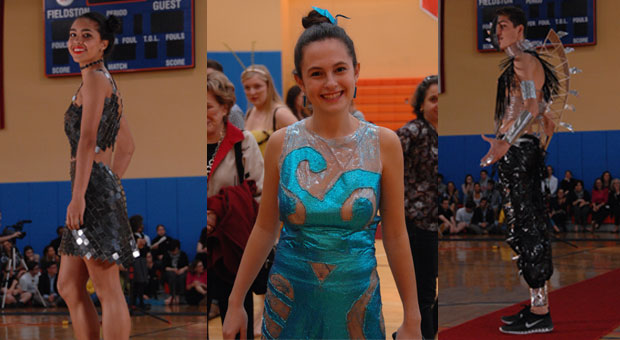 The 2014 Fashion Show was the most successful one so far. The tradition, started nearly ten years ago by Fieldston’s own Nancy Fried, began as a project for her sculpture classes where students walked down the quad during advisory. It then blossomed into a major school wide event that annually draws participants from both the Middle and Upper schools (as well as some faculty members). In the past, CNN, News 12, The New York Times, Teen Vogue, and even a German television station have covered this unique event. Over the years, dresses have evolved from crafts to sculptures to high fashion garments that challenge their cloth competitors. Compared with “Project Runway,” the Fieldston Fashion Show always wins.
The 2014 Fashion Show was the most successful one so far. The tradition, started nearly ten years ago by Fieldston’s own Nancy Fried, began as a project for her sculpture classes where students walked down the quad during advisory. It then blossomed into a major school wide event that annually draws participants from both the Middle and Upper schools (as well as some faculty members). In the past, CNN, News 12, The New York Times, Teen Vogue, and even a German television station have covered this unique event. Over the years, dresses have evolved from crafts to sculptures to high fashion garments that challenge their cloth competitors. Compared with “Project Runway,” the Fieldston Fashion Show always wins.
First to walk down the runway were those who made dresses out of edible materials. This category featured a short cranberry number by Charlotte Rouhandeh (IV), as well as a stunning high-low dress made out of 4,000 gummy bears by Emily Koh (IV). A popular material this year was coffee beans, sacs, and coffee filters fashioned into several different dresses by Macklin Levine (VI), Olivia Rubin (VI), and Nicole Jaffoni (VI). Macklin described the process of making her dress: “I made the top once but it didn’t stay together. I made the skirt again but it didn’t work. By the end I knew what I was doing and it worked.” Emma Kaeser (VI) modeled a long and elegant gown made of potato sacks constructed by her sister Hanna Kaeser (VI).
Choosing a material to make a dress out of might seem simple, but it takes hours and hours of hard work and manipulation to turn a random medium into something that can be worn. In the past students have used duct-tape or netting as a base, but this year Ms. Fried decided that the dresses had to be constructed out of non-fabric material and not be glued onto a base layer.
While some dresses explored natural materials and some were very sculptural, one student, Phoebe Kaufman (VI), used her dress made out of pages from SAT books to display a political message. Kaufman had wanted her dress to read “Fuck the SAT” on the front, but that was censored to “FK the SAT” instead. In an interview with Kaufman, she told me she’d “never made a dress before so I had no idea of what I was doing and it literally took me ten tries to make it not fall off when I put it on. I was at my house over spring break with my friend Julia and we decided to try and make a dress, so I just scrunched paper together, then I tried to tie it together and then I tried to make it a dress!”
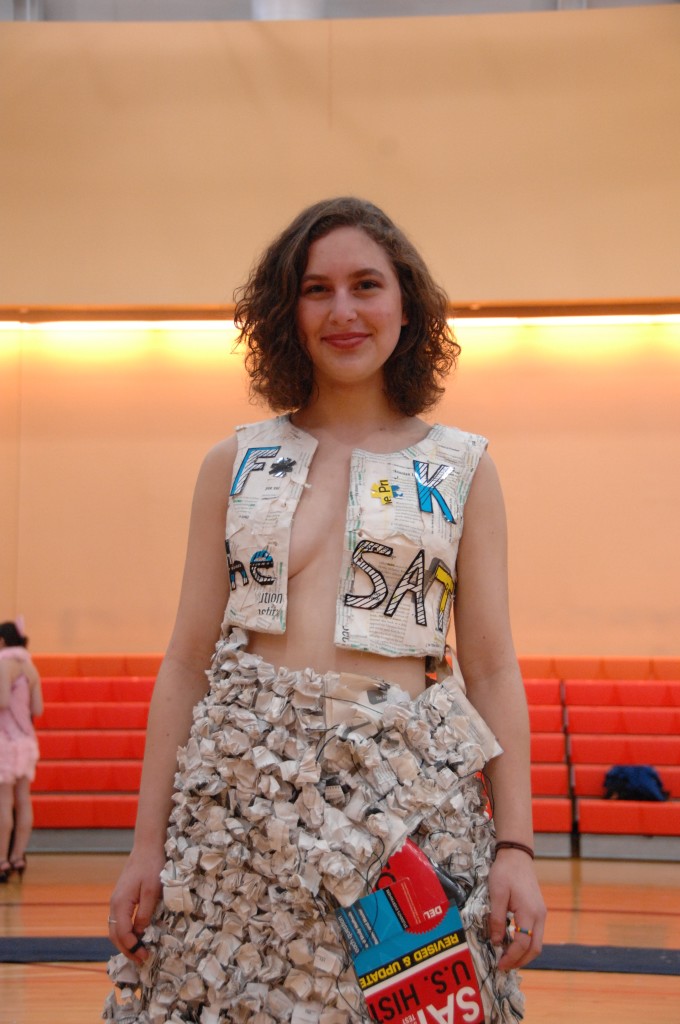 My favorite dresses this year were the ones that showed technical ingenuity and immense creativity in design. One such dress was made entirely from birch bark with no base, crafted by Sophie Hochwald (IV). When asked about the challenges of working with real tree-bark, Sophie said “it’s very stiff and it doesn’t really bend very well, and I was trying to make it bend.”
My favorite dresses this year were the ones that showed technical ingenuity and immense creativity in design. One such dress was made entirely from birch bark with no base, crafted by Sophie Hochwald (IV). When asked about the challenges of working with real tree-bark, Sophie said “it’s very stiff and it doesn’t really bend very well, and I was trying to make it bend.”
Another natural dress was made by Delia Pelli-Walbert (III) whose dress was created out of seaweed. “It flakes off a lot,” she told me. “Then it all just starts to fall apart at a certain point and the challenge is keeping it all together.”
Rachel Scharf (V) made a dress out of binder pins that was a bright gold affair, but it came with a price. “The challenge is that it’s really painful and sharp on the inside,” she said, leaning slightly with pain. “And the fact that it sometimes doesn’t stay together. It’s hard to work with small pieces.”
A stunning example of sculptural achievement was a dress made and worn by Livia Bokor (IV). Her elegant floor-length royal blue gown was made of credit cards that she got customized especially for her dress. “I contacted the company to find a way to get these cards,” says Bokor. “I knew that I wanted to make it floor length so I chose a template and a strategy. The challenge was making the shape fit my body.”
Fitting her dress to her body was a challenge that Maya Newman (VI) also faced. Her Dress was made of saran wrap, glue, and glitter. “The biggest challenge was that whenever I try it on it stretches so I keep having to make it tight It is loose on me now, but it was very tight this morning. The process was long because I had to wait for it to dry. There were layers of glue and then I had to make a new one. ”
In an Interview with Nancy Fried, she told me that Fieldston students have taken such a strong ownership of this project “because it really gives them a chance to be creative with both the materials that they use and the sculpture that they create. Also it’s not graded. It’s an assignment for 45 of the kids, but the other kids just show off what they can do.” To sum up the spirit of the Fieldston Fashion Show, Ms. Fried concluded the interview by saying “‘Only at Fieldston,’ what Dr. Fernandez said is true. Only at Fieldston.”
I sat down with Ms. Fried to learn more about the Fashion Show:
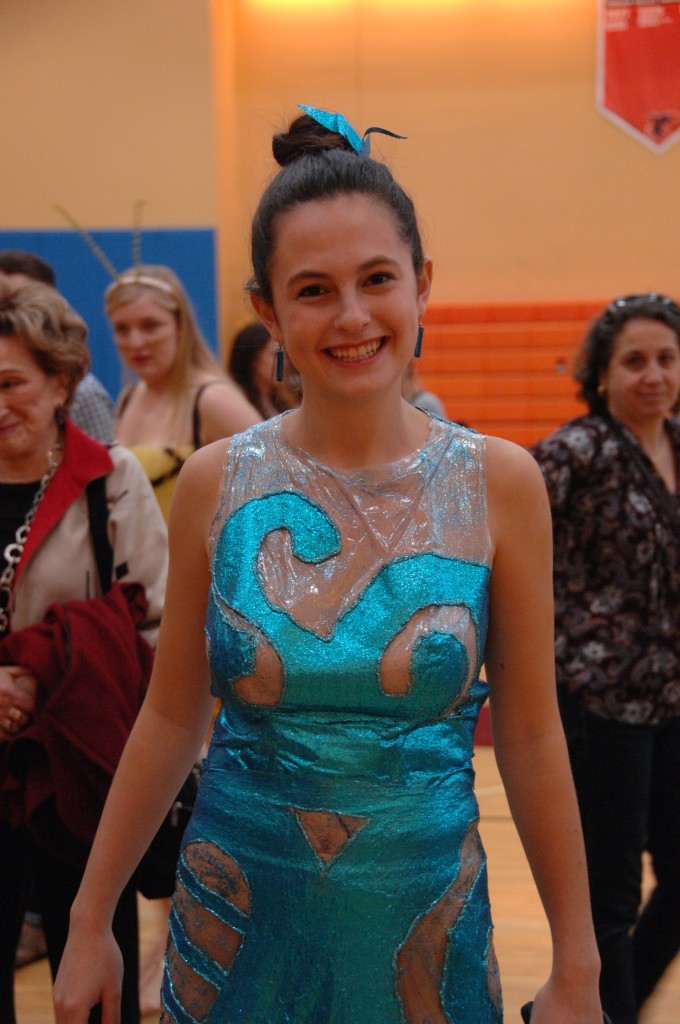 Q: When was the first fashion show that the whole school attended?
Q: When was the first fashion show that the whole school attended?
A: The very first show was on the quad and because it didn’t have a history–it was during advisory and a lot of the kids didn’t come, especially the seniors because it was their last advisory–so the whole school coming was around 9 years ago.
Q: Why do you think that this project has become so popular? What draws Fieldston students to this project?
A: Because I think it really gives them a chance to be creative with both the materials that they use and the sculpture that they create. Also it’s not graded. It’s an assignment for 45 kids, but the other kids just show off what they can do. There’s so much freedom, you work on your own time–it’s a fun experience.
Q: Every year the Art Majors make you a breast—which has been your absolute favorite?
A: To be honest this year’s freaked me out. It was so real! The night before I can’t fall asleep, I’m sitting in the living room. Laura said ‘it’s your choice.’ I went to her to ask if it was okay, then I wished that she would have said no. The morning of the show I told Laura I better not, then Chrissy, Chun’s other mother came in and said “WHAT IT’S ART! You go to a museum and you see sculptures of naked breasts. So I thought “God damn it! It’s art!” The girls spent a long time on it deciding what materials to use. I also loved the one made of pearls from 2 years ago.
Q: In your opinion, what makes a successful dress?
A: The way it is put together. You do not want to see the process; hot glue, tape, for me it is not so much the materials it is the style and the making of it.
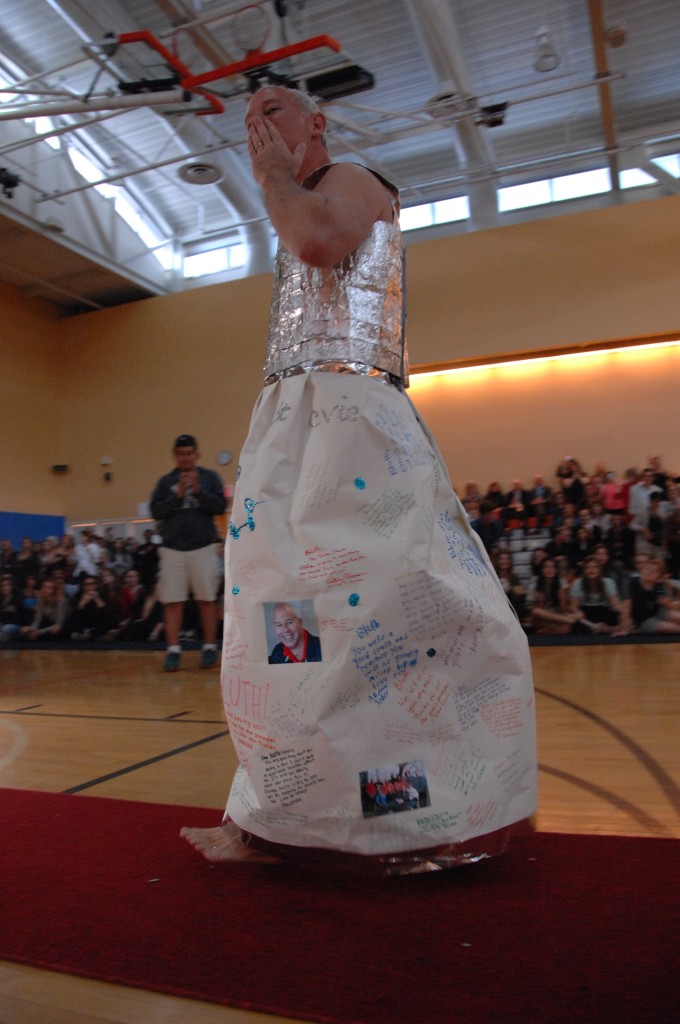 Q: Have you ever had to veto a dress or a dress design/ If so, why?
Q: Have you ever had to veto a dress or a dress design/ If so, why?
A: Yes. Well actually I’ll tell you something that happened this year. I was very busy the morning at the show, I saw a young man and his model wearing an outfit that was such a mess that I am going to tell this student that he can’t be in [the show] next year. If you are doing something messy on purpose, that’s one thing–if it is messy because you just didn’t spend enough time that’s another thing. Some people can do it overnight and it’s gorgeous, some people can’t.
Q: How was this year’s fashion show different? Have you noticed any trends in the materials used over the years?
A: Well one, I think more of them were spectacular. I don’t know how the kids do it but each year they get better. There were 9 less than last year, often people just want to show off and be in it just to be seen. One of the trends that will actually happen—when you see somebody using a material–I think saran wrap is going to be used more. There were more long dresses and more backless dresses that I think was quite elegant.
Q: How do you feel knowing that you have established a Fieldston tradition that is going to last for many years?
A: Overwhelmed. It’s so absolutely moving to see what the kids do and the pride they take in what they’ve done.
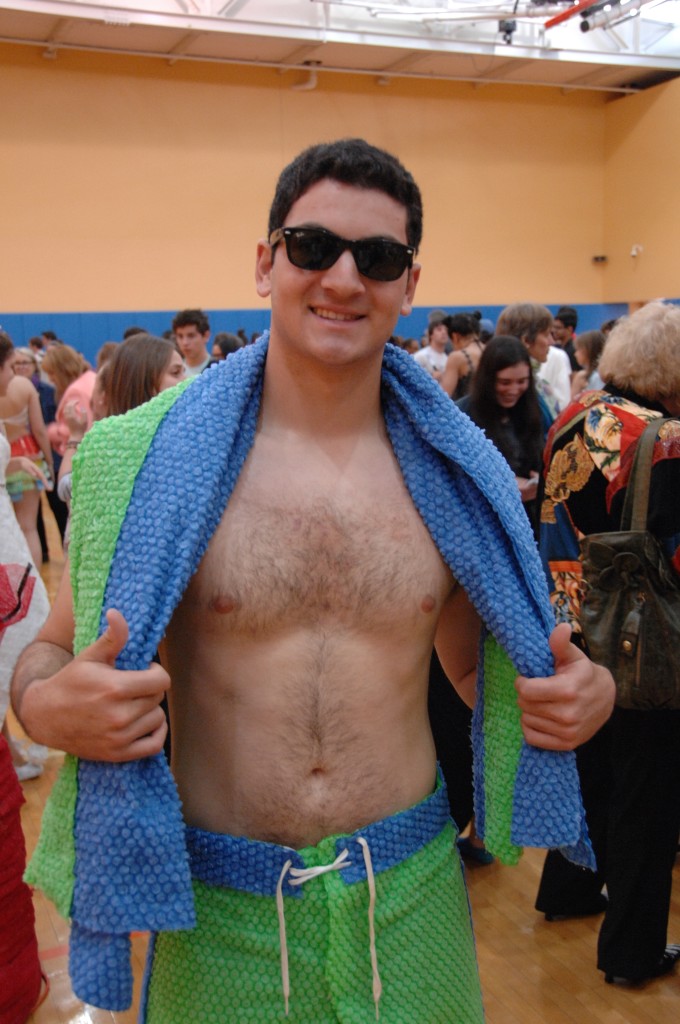 Q: If you had made a dress this year, what material would you have used?
Q: If you had made a dress this year, what material would you have used?
A: I think I would use paper because there is so much you can do with paper. Every year I threaten that my classes will have to use paper so that they are forced to be really creative. focus–but of course they never do it. I would use paper and make something really spectacular.
Q: Is there anything else you would like to add?
A: I think “Only at Fieldston,” what Dr. Fernandez said, is true. Only at Fieldston.

